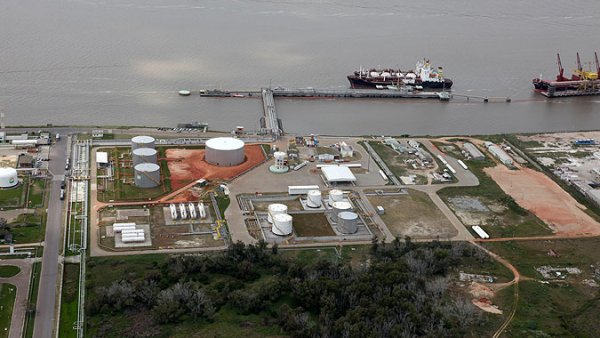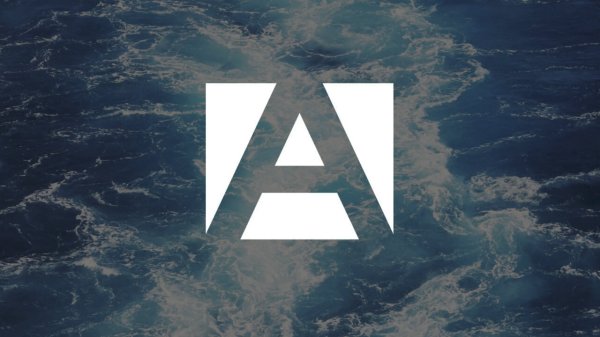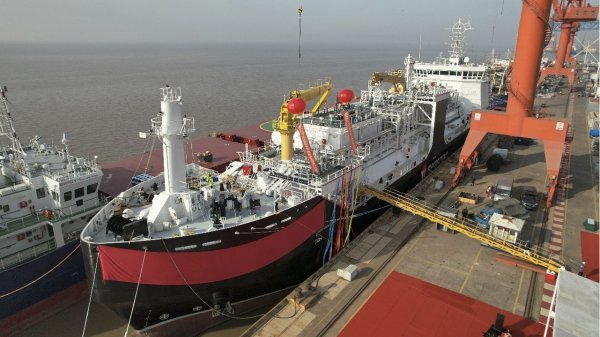Contract signed to build first LNG-fuelled ferry to regularly operate on the Channel
Vessel will also be world's first passenger ship to be equipped with cranes to lift LNG containers into a fixed position.
Brittany Ferries has confirmed the order of a new LNG-fuelled cruise ferry which is due to operate on the company's busiest route from Portsmouth to Caen.
The construction contract was signed with Germany's Flensburger Schiffbau-Gesellshaft shipyard; it follows a letter of intent to build the vessel, which was inked by both parties at the start of this year.
The ferry is slated to commence operating on the Portsmouth to Caen cross-Channel route - which offers three daily return sailings - in the spring of 2019. It is due to operate in tandem with the cruise ferry Mont St Michel, which was launched in 2002.
The ship is to be named Honfleur after the seaside destination on the Seine estuary in Normandy. The budget for the construction of the vessel is approximately GBP 175 million ($223 million).
As reported earlier this year, Total has already signed an agreement with Brittany Ferries for the supply of LNG to the new ferry. Olivier Jouny, Total Marine Fuels' managing director, said in February that deliveries would likely be carried out by truck.
The move to LNG follows a EUR 90 million investment in sulphur- and particulate-reducing scrubber technology. These exhaust emission systems have been retrospectively fitted to six Brittany Ferries ships over the last 18 months in a project supported by around GBP 5 million in joint funding from the EU and its executive agency INEA - and the ADEME in France.
Although the Honfleur is not the first ship to be powered by LNG, it is set to be the first regularly operating on the Channel.
Honfleur will also be the first passenger ship in the world to be equipped with onboard cranes that allow 40-foot (ISO standard) LNG containers to be lifted into a fixed position.
The containers will be transported by truck from an LNG terminal to Ouistreham and then driven on board. They will then be hoisted into position alongside a fixed LNG storage tank located at the rear of the superstructure. Upon the next call at port, empty containers will be removed and replenished with full units.
Power delivery will also be very different to other ferries in the fleet. Powered by LNG using diesel-electric-propulsion, Honfleur's four main engines will feed electric generators and two electric shaft propulsion motors with two fixed pitch efficient propellers. This is designed to optimise fuel consumption at reduced speeds.
Christophe Mathieu, CEO of Brittany Ferries, said the vessel "will reaffirm our position as a class-leading operator thanks to LNG propulsion".
"It is important that we invest in new technologies and new vessels that respect the environment in which we operate," Mathieu added.
Key construction dates:
Finalising the design theme (interior): Summer 2017
First steel cutting: February 2018
Keel laying: June2018
Floating out: November 2018
Sea trials: March 2019
Delivery /naming ceremony: 30 April 2019
Entry into service: Early June 2019
Technical specifications:
Length: 187.4 metres
Breadth: 31 metres
Max Draught: 6.6 metres
Tonnage: 42,400 gross tons
Max speed: 22 knots
Decks: 11
Passengers: 1,680
Vehicle capacity: 2,600 lane metres (130 freight trailers, or 550 cars and 64 freight trailers)
The construction contract was signed with Germany's Flensburger Schiffbau-Gesellshaft shipyard; it follows a letter of intent to build the vessel, which was inked by both parties at the start of this year.
The ferry is slated to commence operating on the Portsmouth to Caen cross-Channel route - which offers three daily return sailings - in the spring of 2019. It is due to operate in tandem with the cruise ferry Mont St Michel, which was launched in 2002.
The ship is to be named Honfleur after the seaside destination on the Seine estuary in Normandy. The budget for the construction of the vessel is approximately GBP 175 million ($223 million).
As reported earlier this year, Total has already signed an agreement with Brittany Ferries for the supply of LNG to the new ferry. Olivier Jouny, Total Marine Fuels' managing director, said in February that deliveries would likely be carried out by truck.
The move to LNG follows a EUR 90 million investment in sulphur- and particulate-reducing scrubber technology. These exhaust emission systems have been retrospectively fitted to six Brittany Ferries ships over the last 18 months in a project supported by around GBP 5 million in joint funding from the EU and its executive agency INEA - and the ADEME in France.
Although the Honfleur is not the first ship to be powered by LNG, it is set to be the first regularly operating on the Channel.
Honfleur will also be the first passenger ship in the world to be equipped with onboard cranes that allow 40-foot (ISO standard) LNG containers to be lifted into a fixed position.
The containers will be transported by truck from an LNG terminal to Ouistreham and then driven on board. They will then be hoisted into position alongside a fixed LNG storage tank located at the rear of the superstructure. Upon the next call at port, empty containers will be removed and replenished with full units.
Power delivery will also be very different to other ferries in the fleet. Powered by LNG using diesel-electric-propulsion, Honfleur's four main engines will feed electric generators and two electric shaft propulsion motors with two fixed pitch efficient propellers. This is designed to optimise fuel consumption at reduced speeds.
Christophe Mathieu, CEO of Brittany Ferries, said the vessel "will reaffirm our position as a class-leading operator thanks to LNG propulsion".
"It is important that we invest in new technologies and new vessels that respect the environment in which we operate," Mathieu added.
Key construction dates:
Finalising the design theme (interior): Summer 2017
First steel cutting: February 2018
Keel laying: June2018
Floating out: November 2018
Sea trials: March 2019
Delivery /naming ceremony: 30 April 2019
Entry into service: Early June 2019
Technical specifications:
Length: 187.4 metres
Breadth: 31 metres
Max Draught: 6.6 metres
Tonnage: 42,400 gross tons
Max speed: 22 knots
Decks: 11
Passengers: 1,680
Vehicle capacity: 2,600 lane metres (130 freight trailers, or 550 cars and 64 freight trailers)

|
IMO approves pricing mechanism based on GHG intensity thresholds
Charges to be levied on ships that do not meet yearly GHG fuel intensity reduction targets. |
|
|
|
||

|
VARO Energy expands renewable portfolio with Preem acquisition
All-cash transaction expected to complete in the latter half of 2025. |
|
|
|
||

|
NYK trials biofuel in milestone coal carrier test
Vessel is used to test biofuel for domestic utility company. |
|
|
|
||

|
H-Line Shipping orders LNG bunkering vessel
Vessel with 18,000-cbm capacity to run on both LNG and MDO. |
|
|
|
||

|
How to engineer and manage green shipping fuels | Stanley George, VPS
Effective management strategies and insights for evolving fuel use. |
|
|
|
||

|
Swedish government bans scrubber wastewater discharges
Discharges from open-loop scrubbers to be prohibited in Swedish waters from July 2025. |
|
|
|
||

|
MAN Energy Solutions achieves 100% load milestone for ammonia engine
Latest tests validate fuel injection system throughout the entire load curve. |
|
|
|
||

|
Petrobras secures ISCC EU RED certification for B24 biofuel blend at Rio Grande
Blend consisting of 24% FAME is said to have been rigorously tested to meet international standards. |
|
|
|
||

|
Stolt-Nielsen to fully control Avenir LNG with acquisition
Share purchase agreement to buy all shares from Golar LNG and Aequitas. |
|
|
|
||

|
Bureau Veritas supports launch of CIMC SOE's LNG bunkering vessel
Handover of Seaspan Energy's cutting-edge 7,600-cbm vessel completed. |
|
|
|
||
Related Links
- · Total inks deal to supply new Brittany Ferries vessel with LNG [Insights]
- · France [Directory]
- · United Kingdom [Directory]

